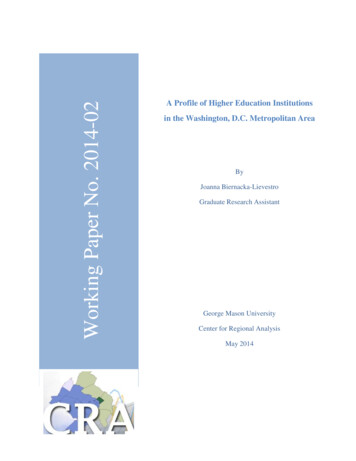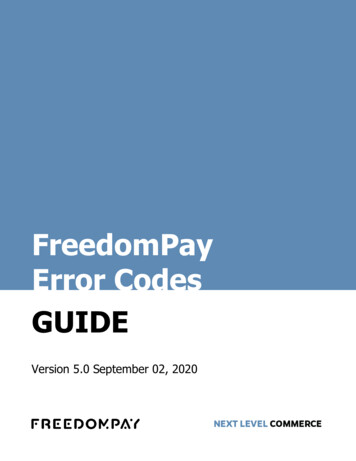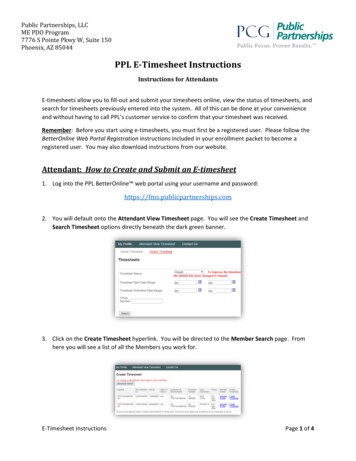
Transcription
Global health problems require global solutions, and public-privatepartnerships are increasingly called upon to provide these solutions.Such partnerships involve private corporations in collaborationwith governments, international agencies, and non-governmentalorganizations. They can be very productive, but they also bring theirown problems. This volume examines the organizational and ethicalchallenges of partnerships and suggests ways to address them.How do organizations with different values, interests, and worldviews come together to resolve critical public health issues? How areshared objectives and shared values created within a partnership?PUBLIC-PRIVATE PARTNERSHIPS FOR PUBLIC HEALTHPublic-Private Partnerships for Public HealthHow are relationships of trust fostered and sustained in the face ofThis book focuses on public-private partnerships that seek toexpand the use of specific products to improve health conditionsin poor countries. The volume includes case studies of partnershipsinvolving specific diseases such as trachoma and river blindness,international organizations such as the World Health Organization,Edited by Michael R. Reichthe inevitable conflicts, uncertainties, and risks of partnership?PUBLIC-PRIVATEPartnerships for Public Healthmultinational pharmaceutical companies, and products such asmedicines and vaccines. Individual chapters draw lessons fromsuccessful partnerships as well as troubled ones in order to helpguide efforts to reduce global health disparities.Published by:Harvard Center forPopulation and Development StudiesHARVARD SERIES ON POPULATIONAND INTERNATIONAL HEALTHEdited by Michael R. ReichISBN 0-674-00865-0HSPH
Public-Private Partnershipsfor Public Health
PUBLIC-PRIVATEPartnerships for Public HealthEdited by Michael R. ReichHARVARD SERIES ON POPULATIONAND INTERNATIONAL HEALTHHarvard Center forPopulation and Development Studies9 Bow StreetCambridge, Massachusetts 02138USAApril 2002Distributed by Harvard University Press
Library of Congress Cataloging in Publication DataPublic-private partnerships for public health / edited by Michael R. Reich.p.cm.-- (Harvard series on population and international health)Includes bibliographical references and index.ISBN 0-674-00865-0 (paperback)1. Public health. 2. Public health–Miscellanea. 3. Public-private sector cooperation I.Reich, Michael R., 1950- II. Series.RA427. P834 2002362.1--dc212001051916 2002, President and Fellows of Harvard CollegeAll Rights ReservedPrinted in the United States of AmericaPublished by:Harvard Center for Population and Development Studies9 Bow StreetCambridge, Massachusetts 02138USAcpds@hsph.harvard.eduCover and Interior design by Carol Maglitta DesignBooks in the Harvard Series on Population and International HealthPublic-Private Partnerships for Public HealthEdited by Michael R. ReichPopulation Policies Reconsidered: Health, Empowerment, and RightsEdited by Gita Sen, Adrienne Germain and Lincoln C. ChenPower & Decision: The Social Control of ReproductionEdited by Gita Sen and Rachel SnowHealth and Social Change in International PerspectiveEdited by Lincoln C. Chen, Arthur Kleinman and Norma C. WareAssessing Child Survival Programs in Developing CountriesBy Joseph J. Valadez
ContentsP R E FA C ECHAPTER 1VII1Introduction: Public-Private Partnerships for Public HealthMichael R. ReichCHAPTER 219Public-Private Partnerships: Illustrative ExamplesAdetokunbo O. LucasCHAPTER 341Cross-Sector Collaboration: Lessons from the InternationalTrachoma InitiativeDiana Barrett, James Austin, and Sheila McCarthyCHAPTER 467The Ethics of Public-Private PartnershipsMarc J. Roberts, A.G. Breitenstein, and Clement S. RobertsCHAPTER 587A Partnership for Ivermectin: Social Worlds andBoudary ObjectsLaura Frost, Michael R. Reich, and Tomoko FujisakiCHAPTER 6115The Last Years of the CVI and the Birth of the GAVIWilliam MuraskinCHAPTER 7169The World Health Organization and Global Public-PrivateHealth Partnerships: In Search of “Good” Global GovernanceKent Buse and Gill WaltCONTRIBUTORS197INDEX199
PrefaceAs we move into the twenty-first century, the face of public health is changing.Governments, international health organizations, and non-governmental organizations, once the central actors in public health initiatives, are looking to theprivate sector for help. At the same time, private for-profit organizations havecome to realize the importance of public health goals for their immediate andlong-term objectives, and to accept a broader view of social responsibility as partof the corporate mandate. Public-private partnerships are becoming a popularmode of tackling large, complicated, and expensive public health problems. Theidea of partnerships for public health has emerged in national as well as international policy discussions, in both rich and poor countries. Yet the new partnersin these initiatives are strangers to each other in many ways. And we are stilllearning about how best to manage these new partnerships. We know little aboutthe conditions when partnerships succeed, about the strategies for structuringpartnerships, or about the ethical underpinnings of partnerships.In April 2000, the Harvard School of Public Health and the Global HealthCouncil organized a small workshop outside Boston to examine questions aboutpublic-private partnerships in international public health. The two-day meetingbrought together 50 people from diverse organizations and contrasting perspectives—international agencies, private corporations, development banks, consumer advocacy groups, private foundations, non-governmental organizations,developing country government officials, and academics of various stripes—toexplore the issues raised by such partnerships, examine their problems and benefits, and address some of the critical questions being raised. The workshop wasjust one in a series of meetings on public-private partnerships organized by manydifferent groups around the world in recent years. This flurry of meetings has created an international dialogue on the role of partnerships in health and development initiatives, seeking to understand how to evaluate, develop, and executepublic health initiatives that involve both public and private partners.The examples presented at our workshop all involved at least one privatecorporation from the pharmaceutical industry and at least one public or nonprofit organization, all engaged in international public health. We focused onpublic-private partnerships seeking to expand the use of specific products withthe potential to improve health conditions in poor countries. For the meeting,we expressly selected papers and participants to represent different views onVII
V I I I P R E FA C Epublic-private partnerships—both critics and supporters—hoping that the formal and informal conversations would advance our collective and individualthinking. The workshop thus sought to provide: Relevant and insightful scholarship on the issues of public-privatepartnerships An open environment to discuss critical questions about public-privatepartnerships An understanding of both the practical and theoretical dimensions of creatingeffective partnerships The creation of a shared ethical vocabulary to serve as the basis for successfulpartnerships in the futureThis book presents the results of the workshop. The essays in this volume offersome fresh perspectives on partnerships, probe some troubling questions, andprovide empirical evidence of both benefits and challenges of public-privatepartnerships. The participants in the meeting also achieved some progress in creating a shared vocabulary, or at least shared understanding, on points of contention, suggesting that dialogue among partisans in public health can helpmove debates about critical issues forward.This volume depended on the contributions of many individuals. A. G.Breitenstein helped organize the workshop with unfailing commitment and goodnature. Professor Marc Roberts, my friend and colleague for the past two decades,provided intellectual support and camaraderie at critical junctures throughoutthe entire project. Scott Gordon and Shoshanah Falek assisted at the workshop,ensuring that the meeting would unfold without major problems. Several colleagues reviewed chapters (some read all of them) and provided comments forauthors: Marc Mitchell, Scott Gordon, Beatrice Bezmalinovic, and Diana Weil.Sarah Madsen Hardy edited the entire volume with great care and sensitivity,clarifying ideas without imposing unduly. The Global Health Council agreed toco-organize the workshop, and I appreciate the participation and support provided by the GHC’s president, Nils Daulaire. Christopher Cahill, responsible forpublications at the Harvard Center for Population and Development Studies,expertly guided the manuscript through its final journey to appear as a book.Finally, the authors graciously responded to my comments and queries andrespected the timetables and deadlines. Reflecting on this process reminds methat the production of an edited volume is itself a partnership. While producing
P U B L I C - P R I V AT E P A R T N E R S H I P S F O R P U B L I C H E A L T H I Xthe book required more time than I had hoped (the nature of partnerships),the volume improved from the contributions of others and truly represents ajoint product.Finally, I express appreciation for the financial support for the workshop andthe book provided by four organizations: the Edna McConnell Clark Foundation,Merck & Co., Pfizer Inc, and SmithKline Beecham (now GlaxoSmithKline).While these organizations provided funding for the meeting and are all engagedin public-private partnerships, they did not influence the selection of paper writers or topics, the content of the papers, or the agenda for the workshop. Theygranted us independence in organizing the meeting and stood behind ourapproach of inviting people with a broad range of perspectives on public-privatepartnerships—including people of skeptical and critical views—supporting ourguarantee of an open discussion from all perspectives.Michael R. ReichHarvard Center for Population and Development StudiesAugust 2001
1Public-Private Partnerships forPublic HealthMichael R. ReichPUBLIC-PRIVATE PARTNERSHIPS ARE AT THE TOP OF MANY AGENDAS in international public health these days. When the market fails to distribute health benefits to people who need them—especially to poor people in developingcountries—partnerships between public and private organizations are often seenas offering an innovative method with a good chance of producing the desiredoutcomes. But these partnerships also bring their own problems and controversies. Health activists and researchers have criticized partnerships for divertingresources from public actions and distorting public agendas in ways that favorprivate companies. This book addresses the organizational and ethical challengesof such public-private partnerships.Recently, many organizations in public health have established partnershipswith private-sector organizations. Academic institutions have created partnerships with private companies for specific research activities, such as the development of new therapies (Blumenthal et al., 1996). The World Bank hasannounced that it will encourage partnerships as part of its comprehensive development framework. The director-general of the World Health Organization(WHO) called for “open and constructive relations with the private sector andindustry” in her first speech after her 1998 election (WHO, 1998). Non-governmental organizations have established new relationships with private for-profitfirms and with international agencies. Similar trends are apparent in other international health organizations, particularly in efforts to expand access to drugsand vaccines in poor countries (“The need for public-private partnerships,”2000; Harrison, 1999; Reich, 2000; Smith, 2000). In the United States, “hundreds of millions of dollars” have been invested to promote partnerships aroundhealth issues, creating “thousands of alliances, coalitions, consortia and otherhealth partnerships” (Lasker, Weiss & Miller, 2001, p. 179).1
2 C H A P T E R 1 Michael R. ReichBut why have public-private partnerships become so prominent at this time?One reason is that public health problems are being pushed onto the international policy agenda, with a rise in advocacy by non-governmental organizationsthat have gained increasing influence over the past two decades. Globalizationprocesses have promoted the growth and influence of non-governmental organizations in international health (Brown et al., 2000). An example is the campaign by Médecins Sans Frontières to expand access to essential drugs. At thesame time, private foundations in the United States have assumed an increasingly active role in creating and supporting public-private partnerships, exemplified by the grants from the Bill and Melinda Gates Foundation, theRockefeller Foundation, and the Edna McConnell Clark Foundation. The problems addressed by partnerships often involve issues of health equity between therich and the poor of the world. With globalization, new technologies comequickly to market and spread across rich countries, while the persistent lack ofaccess in poor countries creates a stark and tragic contrast. This gap in access cancreate dramatic differences in morbidity and mortality, as shown by the unequalaccess to anti-AIDS drugs in the 1990s.Yet neither public nor private organizations are capable of resolving suchproblems on their own. Traditional public health groups are confronted by limited financial resources, complex social and behavioral problems, rapid diseasetransmission across national boundaries, and reduced state capabilities. At thesame time, private for-profit organizations have come to recognize the importance of public health goals for their immediate and long-term objectives, and toaccept a broader view of social responsibility as part of the corporate mandate.Pharmaceutical companies, for example, have become involved in a number ofhigh-visibility drug donation programs based on partnerships (see table 2.1). Inshort, both public and private actors are being driven towards each other, withsome amount of uneasiness, in order to accomplish common or overlappingobjectives. In the United States, public and private funding agencies have promoted partnerships in public health on the assumption that they would “enabledifferent people and organizations to support each other by leveraging, combining, and capitalizing on their complementary strengths and capabilities” (Lasker,Weiss & Miller, 2001, p. 180).Yet we know little about the conditions when partnerships succeed.Partnerships can produce innovative strategies and positive consequences forwell-defined public health goals, and they can create powerful mechanisms for
P U B L I C - P R I V AT E P A R T N E R S H I P S F O R P U B L I C H E A L T H 3addressing difficult problems by leveraging the ideas, resources, and expertise ofdifferent partners. At the same time, the rules of the game for public-private partnerships are fluid and ambiguous. Since no single formula exists, constructing aneffective partnership requires substantial effort and risk. How then do organizations with different values, interests, and worldviews come together to address andresolve essential public health issues? What are the criteria for evaluating the success of public-private partnerships? Who sets these criteria, and with what kindsof accountability and transparency?This book is organized to address these questions as follows: This introductory chapter summarizes the major issues reflected in the papers presented andensuing discussion at the workshop held in April 2000 (organized by the HarvardSchool of Public Health and the Global Health Council). Chapter 2 providestwo illustrative examples of public-private partnerships. Chapters 3 and 4 examine successful partnerships, and chapter 5 looks at a troubled partnership and thelessons learned. The final two chapters present differing perspectives on the roleof private corporations in partnerships. Chapter 6 argues that private corporations have an ethical obligation to engage in partnerships for health improvement in poor countries, while chapter 7 argues that such partnerships are likelyto have a negative impact on United Nations organizations and, therefore,should be strictly regulated and monitored.Defining PartnershipsWhat is a public-private partnership? A good working definition would includethree points. First, these partnerships involve at least one private for-profitorganization and at least one not-for-profit or public organization. Second, thepartners have some shared objectives for the creation of social value, often fordisadvantaged populations. Finally, the core partners agree to share both effortsand benefits.But this working definition contains many ambiguities, raising importantquestions and issues. One set of questions focuses on the nature of public and private. What is public? What is private? The public sector category certainlyincludes national governments and international agencies (such as WHO andthe World Bank). And the private sector category certainly includes for-profitcorporations. But where do international non-governmental organizations(NGOs) fit? Organizations such as Médecins Sans Frontières and Helen KellerInternational are private in the sense that they do not belong to a governmental
4 C H A P T E R 1 Michael R. Reichstructure, yet they seek to promote public interests. These non-governmentalorganizations belong to civil society, a third sector (in addition to the public andprivate sectors), and are sometimes called civil society organizations. Brown etal. (2000) define civil society as “an area of association and action independentof the state and the market in which citizens can organize to pursue social valuesand public purposes which are important to them, both individually and collectively” (p. 7). We can view such organizations as belonging to the public side ofthe equation of public-private partnerships, while recognizing that NGOs areoften considered as a third sector on their own, reflecting different values, purposes, interests, and resource mobilization strategies. Private foundations are similar to NGOs, as civil society organizations seeking to promote public interests.We can also consider these foundations on the public side of public-private partnerships, although they lack the formal institutions of public accountabilityfound in governments and inter-governmental agencies. (Indeed, some arguethat private foundations have too much power to set public agendas, without sufficient public oversight and input.) As the case studies show, many differentkinds of organizations are joining public-private partnerships, and they bringwith them different cultures, governance structures, and financial resources.These differences create challenges in the partners’ efforts to collaborate effectively and achieve their objectives.A second set of questions addresses the nature of partners. Who is a partner,and who should decide? For example, should the recipients of a public-privatedrug donation program be considered partners? Should these recipients participate in the design, implementation, and oversight of a public-private partnership?If so, in what ways? What kind of governance structure could allow the participation of recipients and promote accountability while assuring effectiveness?Partnerships can involve a range of partners with different rights and responsibilities, including core partners, who assume key responsibilities for the jointenterprise, and in-country partners, whose participation is necessary for successful implementation. Some partnerships give prominent roles in governing structures to recipients, while others do not. Specific cases demonstrate the diversityof organizations within a single partnership. For example, the InternationalTrachoma Initiative involves two core partners—Pfizer (a private for-profit pharmaceutical company) and the Edna McConnell Clark Foundation (a privatefoundation)—plus many additional partners, including national governments,other private foundations and non-governmental organizations (such as Helen
P U B L I C - P R I V AT E P A R T N E R S H I P S F O R P U B L I C H E A L T H 5Keller International), and the World Health Organization (see chapter 3). Thechapters in this book discuss a number of important issues related to partnershipstructures, including the processes through which partnerships are formed, theways in which different organizations relate to each other, and the broader policy implications of public-private partnerships.Diversity of PartnershipsMany kinds of public-private partnerships for health have emerged in recentyears. The Initiative on Public-Private Partnerships for Health (located inGeneva, with the Global Forum on Health Research) is creating an inventory ofpartnerships, using ten different categories (table 1.1). Its list included over sixtydifferent public-private partnerships for health as of October 2000. These partnerships include at least 16 major efforts that involve WHO in significant ways(table 1.2). Several prominent examples are worth noting briefly here.One example is the Accelerating Access Initiative, an effort by five pharmaceutical companies, announced in May 2000, to collaborate with five international agencies in finding mechanisms to provide access to HIV/AIDS-relatedcare and treatment in poor countries, including significant price discounts foranti-AIDS drugs (UNAIDS, 2000). One year later, agreements had beenreached in only three countries—Senegal, Rwanda, and Uganda. This reflectsthe difficulties in moving from dialogue to action (Schoofs & Waldholz, 2001).Table 1.1C AT E G O R I E S O F P U B L I C - P R I VAT E PA R T N E R S H I P S F O R H E A LT H1. Partnerships for disease control—product development2. Partnerships for disease control—product distribution3. Partnerships for strengthening health services4. Partnerships to commercialize traditional medicines5. Partnerships for health program coordination6. Other international health partnerships7. Country level partnerships8. Private sector coalitions for health9. Partnerships for product donations10. Partnerships for health service deliverySource: Widdus et al., 2001.
6 C H A P T E R 1 Michael R. ReichTable 1.2L I S T O F W H O P U B L I C - P R I VAT E PA R T N E R S H I P SEuropean Partnership Project on Tobacco DependenceGlobal Alliance for TB Drug DevelopmentGlobal Alliance to Eliminate Lymphatic FilariasisGlobal Alliance to Eliminate LeprosyGlobal Alliance for Vaccines and ImmunizationGlobal Elimination of Blinding TrachomaGlobal Fire Fighting PartnershipGlobal Partnerships for Healthy AgingGlobal Polio Eradication InitiativeGlobal School Health InitiativeMultilateral Initiative on MalariaMedicines for Malaria VenturePartnership for Parasite ControlRoll Back MalariaStop TB InitiativeUNAIDS/Industry Drug Access InitiativeSource: World Health Organization website (www.who.int) search on ‘partnership’ and ‘global alliance’.The conflicts over expanding access to anti-retrovirals provide a striking counterpoint, along several dimensions, to the partnership that arose to provideaccess to ivermectin for onchocerciasis. The nature of the disease and the treatment, the markets and profits of the products, the political context, the positionsof governments, the economic and social costs—all make a difference in thecapacity of public-private partnerships to achieve results.A second example is the Global Alliance for Vaccines and Immunizations(GAVI), whose origins are described by William Muraskin in chapter 6 of thisvolume. This partnership was galvanized by a five-year commitment of 750 million from the Gates Foundation in November 1999, and has subsequentlyreceived contributions from the governments of Norway, the Netherlands, theUnited Kingdom, and the United States, for a total fund of over a billion dollars.The partners for GAVI include: national governments, the Gates Children’sVaccine Program at PATH, the International Federation of PharmaceuticalManufacturers Associations (IFPMA), research and public health institutions,
P U B L I C - P R I V AT E P A R T N E R S H I P S F O R P U B L I C H E A L T H 7the Bill and Melinda Gates Foundation, the Rockefeller Foundation, the UnitedNations Children’s Fund (UNICEF), the World Bank Group, and the WorldHealth Organization. GAVI has made a number of grants to developing countries to support immunization programs and may also provide financial supportfor the development of new vaccines (GAVI, 2000).A third example of a recently formed partnership is the Medicines forMalaria Venture (MMV). This entity has been established as an independentfoundation under Swiss law, and operates as a non-profit business to spur development of new antimalarial drugs, using a public venture capital fund and a smallmanagement team (Ridley & Gutteridge, 1999). The MMV partners include:the World Health Organization, the International Federation of PharmaceuticalManufacturers Associations, the World Bank, the government of theNetherlands, the UK Department for International Development, the SwissAgency for Development and Cooperation, the Global Forum for HealthResearch, the Rockefeller Foundation, and the global Roll Back MalariaPartnership. The president of the IFPMA stated that the MMV symbolizes “thestart of a new era of partnership between the research-based pharmaceuticalindustry and the WHO to bring about real improvements in world health”(MMV, 1999).A fourth example is the partnership to assure continued availability of a lifesaving drug, eflornithine, to treat human African trypanosomiaisis. This partnership involves private companies, non-governmental organizations, and theWHO in an unusual collaboration. In December 1999, the manufacturer foreflornithine, Hoechst Marion Roussel (now Aventis), donated the patent rightsand manufacturing know-how to WHO. Then WHO and Médecins SansFrontières (MSF) sought to find a third party manufacturer willing to producethe drug, which MSF would distribute in sleeping-sickness treatment programsin affected countries (Pecoul & Gastellu, 1999). In the fall of 2000, BristolMyers Squibb (along with several other companies) introduced an eflornithinecream for removing facial hair in women—a lifestyle drug for sale in rich-country markets—perhaps without full understanding of the implications of producing a drug that has other applications in tropical medicine. These companies,including Aventis, subsequently agreed in February 2001 to provide WHO andMSF with sixty thousand doses of eflornithine—enough to last three years(“New lease on life,” 2001). And in May 2001, Aventis reached an agreementwith WHO to donate three drugs for treating sleeping sickness for five years
8 C H A P T E R 1 Michael R. Reich(valued at 5 million per year) plus funding to support WHO’s research programs(MSF, 2001). This partnership emerged from the campaign for drug access carried out by Médecins Sans Frontières, and was based in part on twenty years ofcollaborative research between Hoechst Marion Roussel and the United NationsDevelopment Program/World Bank/WHO Special Program for Research andTraining in Tropical Diseases (TDR) to support the discovery and developmentof eflornithine.These examples show that public-private partnerships for health (even considering only five involving WHO) are diverse in many respects: the number ofpartners involved, the kinds of organizations involved, the funding levels andfunding sources, the objectives for the partnerships, and the organizational structures of the partnerships. What factors have motivated these disparate organizations to come together in partnerships?Motives for Initiating PartnershipsUntil recently, the public and for-profit private sectors working in the healtharena often viewed each other with “antagonism, suspicion, and confrontation,”as reported by Adetokunbo Lucas (see chapter 2). These tensions are now beingsupplanted by increasing rapprochement and positive encouragement for publicprivate partnerships in health. According to Lucas, a chief factor encouragingthese partnerships is that neither side alone can achieve its specific goals; collaboration is unavoidable to solve certain problems. Multi-member partnerships,which have recently become popular, reflect a recognition that some problemsrequire many partners and complex organizational mechanisms to address all thedifferent aspects.The chapter by Lucas discusses partnerships initiated by the UNDP/WorldBank/WHO Special Program for Research and Training in Tropical Diseases(TDR). Lucas served as TDR director from 1976 to 1986, and understood thatpublic-private partnerships were essential for progress on TDR’s mandate of discovering and developing new and improved technologies for the control of tropical diseases affecting the poor in developing countries. This goal could not beachieved through efforts by either the public sector or the private sector workingalone. The case of TDR shows persuasively that the public sector can work withthe private sector in ways that advance public interest.Lucas also presents four cases of philanthropic drug donation programs (table2.1). These efforts by pharmaceutical companies require clearly defined public
P U B L I C - P R I V AT E P A R T N E R S H I P S F O R P U B L I C H E A L T H 9health goals, involve several components (beyond the product) in a strategicplan for addressing the problem, and depend on the collaborative efforts of several partners. These partnerships were pursued, according to Lucas, because therewere no viable alternatives to solve the problems of drug development and distribution. Moreover, in cases
public health initiatives that involve both public and private partners. The examples presented at our workshop all involved at least one private corporation from the pharmaceutical industry and at least one pub










